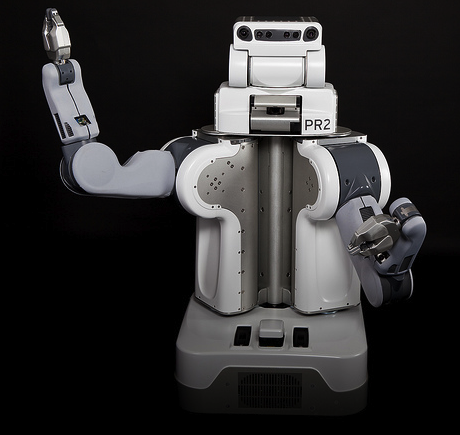Fort Robot Mac OS
In image template-based desktop automation, you provide the robot with screenshots of the parts of the interface that it needs to interact with, like a button or input field. The images are saved together with your automation code. The robot will compare the image to what is currently displayed on the screen and find its target.
- I have some problems with my new 27 Imac Mac OS x 10.6.6 and Teamspeak3 client. Headset is a Sennheiser that work together with Speedlink USB Soundcard. Everything works fine but sometimes my voice suddenly sounds like a robot.-Is there a way to stop this? Thanks for help greetings.
- The Mac OS X novelty voice 'Boing' was used for the Robot face (SSF/Splaat) for Klasky Csupo. In one of Boomerang's older blocks Boomeraction, the voice used for the block was a low pitch version of the 'Trinoids' novelty voice.
Cross-platform desktop automation library
Robocorp provides cross-platform desktop automation support with the RPA.Desktop library. It works on Windows, Linux, and macOS.
By running the ankivector.configure executable submodule, you will be asked to provide your Anki account credentials, and the script will automatically download an authentication token and certificate to your computer that will grant you access to the robot and his capabilities (such as camera and audio) as well as data stored on the robot (such as faces and photos). The VM is Windows 7 SP1 with all updates applied until yesterday. I have the 3D acceleration enabled, and it seems to run fine. But however, note that Robot needs resources: You need a Mac with preferably 16GB RAM (so that you can assign 8GB to the VM) and a relatively recent CPU, with preferably a good GPU as well. A robot malfunction or security breach would wreak havoc on your business's reputation, productivity, and worker safety. FORT solves for these worst-case scenarios so you don’t have to. Our ecosystem brings together the safety and security you need to stay in control.
Travel directions robot
This example robot demonstrates the use of image templates and keyboard shortcuts to find travel directions between two random locations on Earth.
The robot:
- Interacts with a web browser to select two random locations on Earth (from https://www.randomlists.com/random-location).
- Tries to find the directions using the Maps desktop app on macOS (Big Sur), using image templates and keyboard shortcuts.
- Falls back on the web version of Google Maps if Maps fails to find directions.
Note: This robot requires macOS Big Sur. The layout and the behavior of the Maps app vary between macOS releases. macOS will ask for permissions the first time you run the robot. Go to System Preferences ->Security & Privacy and check Robocorp Lab, Code, or Terminal (depending on where you run the robot from) in the Accessibility and Screen Recording sections.
Another important topic:
System settings can impact the recognition of the images: How the interface elements look on a screen depends on system settings like color schemes, transparency, and system fonts. Images taken on a system might end up looking different than the target system, and the robot might not recognize them, stopping the process.
In this case, macOS should use the 'Dark' appearance under System Preferences ->General. See our Desktop automation page for more information.
The settings

The robot uses three libraries to automate the task. Finally, it will close all the browsers it happened to open.
The task: Find travel directions between two random locations
Variables
Keyword: Get random locations
The robot uses a web browser to scrape and return two random locations from a suitable website.
Keyword: Open the Maps app
The robot opens the Maps app using the Run Process keyword from the Process library. It executes the open -a Maps command. You can run the same command in your terminal to see what happens!
The robot knows when the Maps app is open by waiting for the Maps.MapModeimage template to return a match.
Keyword: Maximize the window
The robot maximizes the Maps app window using a keyboard shortcut unless the app is already maximized. The Run Keyword If is used for conditional execution.
The robot knows the Maps app is maximized when the Desktop.WindowControls image template does not return a match (when the close/minimize/maximize icons are not anywhere on the screen).
Keyword: Open and reset the directions view
The robot sets the directions view in the Maps app to a known starting state (empty from and to locations).
Fort Robot Mac Os X
- Conditional execution is used to handle the possible states for the view (it might or might not be open already).
- Image templates are used to wait for specific app states so that the robot knows when something has been completed.
- Keyboard shortcuts are used to toggle the directions view.
Keyword: Accept Google consent
Keyword: View directions using Google Maps
The robot waits until Google Maps has loaded the directions and takes a full web page screenshot.
Keyword: Enter location
The robot needs to input the from and to locations. This keyword provides a generic way to target those elements on the UI.
Fort Robot Mac Os 11
Keyword: View directions
The robot tries to find the directions using the Maps app. If that fails, the robot gets the directions from Google Maps.
Summary
Fort Robot Mac Os Download
- Image template matching is a cross-platform way to find and target UI elements.
- Keyboard shortcuts are the preferred way to interact with desktop applications (the shortcuts are usually more stable and predictable than the UI).
- Conditional logic can be used to select different actions based on the state of the application.